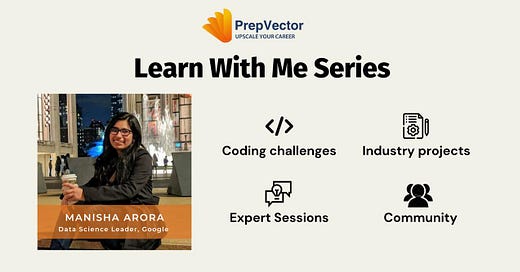Mastering SQL Aggregations: Building Blocks of Data Insights
Explore the fundamentals of SQL aggregations used for summarizing and analyzing large datasets. Mastering these functions will empower you to efficiently extract key insights from your data
👋 Hey! This is Manisha Arora from PrepVector. Welcome to the Tech Growth Series, a newsletter that aims to bridge the gap between academic knowledge and practical aspects of data science. My goal is to simplify complicated data concepts, share my perspectives on the latest trends, and share my learnings from building and leading data teams.
Hello SQL Enthusiasts,
Welcome to the first edition of SQL Insights! This week, as part of our LinkedIn SQL Tips Series, we’ve published a focused set of posts on aggregating data—a fundamental skill every data professional must master. Whether you're reporting key metrics, analyzing trends, or summarizing large datasets, aggregation queries are essential when working with big data.
This is just the beginning! These posts are part of the larger Learn Data Science with Me initiative, a collaboration between Manisha, Sai, and Siddarth. Together, we’re creating a community-driven learning experience designed for professionals who want to deepen their data science expertise.
What is the Learn Data Science with Me Initiative?
I’ve set a personal goal to upskill 1,000 data professionals in 3 months, and I’m thrilled to have you join this journey. It’s all about building practical skills, engaging with thought leaders, and tackling real-world challenges together.
This initiative will be an immersive learning experience focused on industry learnings, skills, and use cases. Here’s what you can expect:
✅ Coding Challenges: Practical SQL, Python, and ML problems to sharpen your problem-solving skills
✅ Paper Reading Sessions: Discussions on cutting-edge research papers and blogs to bridge theory and practice
✅ Speaker Sessions: Interactive Q&A and deep dives into trending industry topics
✅ AMA Discussions: Open forums for real-time learning and insights
The 15-day SQL Challenge, launching in March, is the first structured challenge of the series! If you enjoyed this week’s aggregation-focused content, get ready for what’s next. The challenge will cover everything from writing efficient queries to mastering advanced SQL optimizations, ensuring you build a strong foundation in SQL.
Deep Dive into SQL Aggregation Functions
1. Understanding Data Aggregation in SQL
At its core, aggregation in SQL is the process of summarizing or transforming your data into meaningful insights. Common aggregation functions like COUNT(), SUM(), AVG(), MIN(), and MAX() are used to perform operations on your data and return a single value or summary result.
Here’s a quick refresher on how these functions work:
SELECT
COUNT(*) AS total_orders,
SUM(total_amount) AS total_revenue,
AVG(order_value) AS average_order_value,
MIN(order_date) AS earliest_order,
MAX(order_date) AS latest_order
FROM orders;This query will give you important insights like the total number of orders, total revenue, average order value, and the date range for orders.
2. Grouping Data with GROUP BY
When you need to break down data by specific categories (e.g., by region, by product type, by month), you’ll use the GROUP BY clause. It’s one of the most commonly used methods for aggregating data at different levels.
Let’s say you want to see the total sales by each product category. Here’s how you’d write the query:
SELECT
category,
SUM(sales) AS total_sales
FROM products
GROUP BY category;This will group your data by product category and sum up the sales in each category. A critical thing to remember: whenever you're using aggregation functions, you often need to include a GROUP BY clause to specify how to group the data.
3. Filtering Aggregated Data with HAVING
While the WHERE clause filters rows before aggregation, the HAVING clause filters results after aggregation. It’s perfect when you need to work with aggregated results and apply additional conditions.
For example, you may want to see only product categories with total sales over $10,000:
SELECT
category,
SUM(sales) AS total_sales
FROM products
GROUP BY category
HAVING SUM(sales) > 10000;The HAVING clause lets you fine-tune the data that’s returned after aggregation.
Quick Tips & Best Practices
Think about performance: Aggregating large datasets can be resource-intensive. Ensure you're indexing the right columns (like foreign keys or commonly filtered columns) to optimize query performance.
Use subqueries for complex aggregations: Sometimes you may need to aggregate data in stages. Subqueries are a great way to handle these situations effectively.
Keep it simple: While SQL provides a lot of powerful functions, always ensure your queries are easy to read and maintain. Write queries that are clear for you and your team.
Exciting Announcement: The 15-Day SQL Challenge!
Are you ready to test your SQL skills and take them to the next level? We’re excited to announce our 15-Day SQL Challenge, which kicks off in March! Here’s how it works:
One question per day for 15 days: You’ll receive a daily SQL problem, ranging from beginner to advanced topics, to help you sharpen your skills.
Leaderboard: Track your progress and compare your performance with others on the leaderboard!
Rewards: Those who complete the challenge will receive exciting rewards and recognition.
This is the perfect opportunity to challenge yourself, compete with your peers, and grow your SQL knowledge!
Don’t miss out! The challenge is going to be a blast. Let’s get ready to level up your SQL skills together!
🚀 Join Our Data Science Community!
Become a part of the Learn Data Science with Me community and connect with fellow professionals on the same journey. Get access to exclusive content, participate in interactive discussions, and stay updated on challenges, speaker events, and more. Join us today and accelerate your learning with a supportive network of data science enthusiasts!
That’s it for this week’s edition of SQL Insights!
Next week, we’ll dive into joining datasets, which will take your SQL skills to the next level. Stay tuned!
Happy querying!





